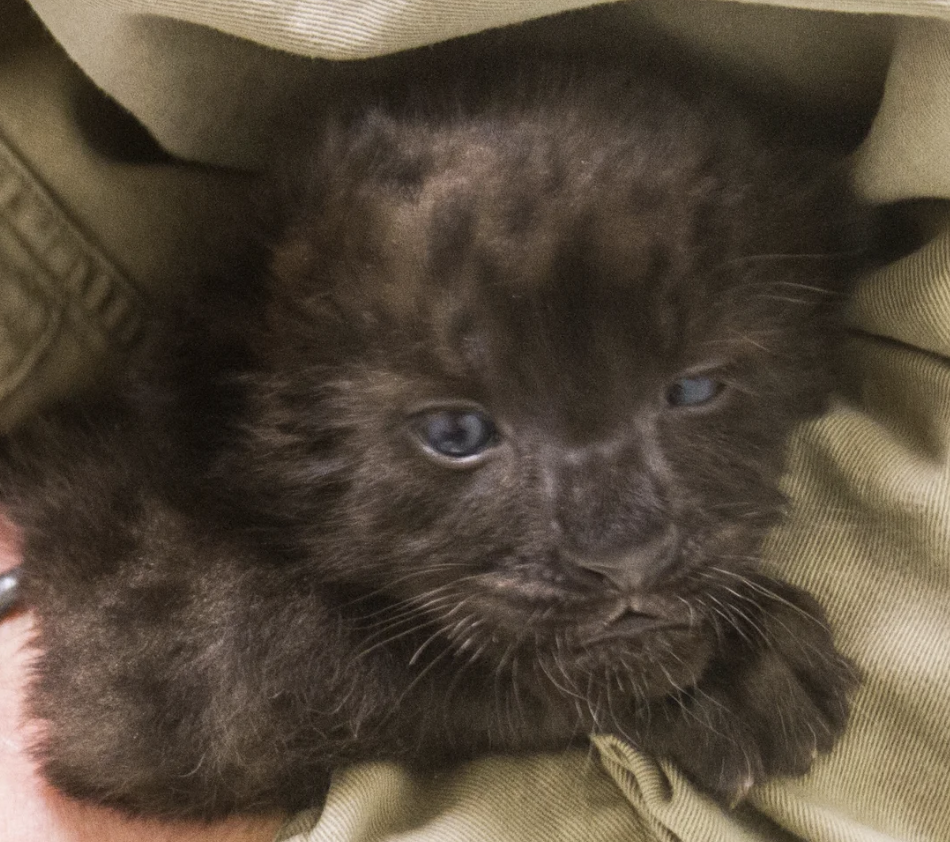
BRIDGEPORT, Conn. – Connecticut’s Beardsley Zoo’s six-year-old Amur leopard (Panthera pardus orientalis), Freya, gave birth to three cubs on January 25, with two cubs surviving. The surviving cubs, a male and a female, were removed from Freya when she began hyper-grooming behaviors, which posed a danger to their wellbeing. One cub was euthanized due to maternal-induced injuries. Both six-week-old cubs are in seclusion in the Zoo’s Animal Health Care Center.
The surviving female cub suffered the loss of her tail due to the hyper-grooming, and underwent lifesaving surgery shortly after birth. She was treated with antibiotics for an infection, but has completed the medication and is doing well.
Amur leopards are critically endangered, which means they face an extremely high risk of extinction in the wild, with approximately 80 animals remaining there. There are approximately 200 in human care worldwide, with slightly more than 100 in Russia and Europe, and slightly fewer than 100 in the U.S. With such a small population, each Amur leopard born is extremely important to the survival of the species. Six Amur leopard cubs were born in the U.S. in 2018, with five surviving.
“Amur leopards are on the brink of extinction,” said Zoo Director Gregg Dancho. “The Species Survival Plan’s breeding recommendation is designed to bolster the number of individuals in human care, for potential future breeding, as well as the opportunity to return certain members of the species back to the wild someday. The birth of these cubs brings a few more precious Amur leopards to the population, which can help ensure the survival of these majestic animals for future generations.”
Zoo veterinary and animal care staff are providing around the clock care, hand feeding the babies five times a day, with a feline milk replacement formula, supplemented with vitamins. In the past several weeks, both cubs have increased in weight, to roughly 2.5 kilos each (5.5 lbs.).The male cub is somewhat larger than the female. Zoo staff was aware of the leopard’s pregnancy through fecal hormone testing and weight gain, and had been keeping a 24-hour watch on Freya during the weeks leading up to the cubs’ birth. The cubs’ survival to six weeks is a critical milestone.It will be several more weeks before the cubs will be available for viewing by the public.
The female cub has melanism, an extremely rare black color variant in big cats. Melanistic cats have a condition where the body produces an excess of black pigment, the opposite of albinism. There are nine leopard subspecies, ranging from Africa all the way to the Amur leopard in eastern Russia. And while 11 percent of leopards alive today are thought to be melanistic, most are found in Southeast Asia, where tropical forests offer an abundance of shade. An extremely rare melanistic leopard was recently sighted in Africa for the first time in a century. There is currently one other melanistic Amur leopard in this country at the San Diego Zoo.
The Zoo is home to the cubs’ parents: a female, Freya, born in 2013, from the Copenhagen Zoo, and a male Sochi, born in 2013, from the Denver Zoo. Their habitat features rock outcroppings that enable the leopards to explore their surroundings at ground level. It also includes areas as high as 10 feet off the ground, to enable them to view their domain from a different level. Amur leopards have been known to leap more than 10 feet vertically, so there is plenty of room to stretch their legs.
According to the Association of Zoos and Aquariums’ (AZA), the goal of the SSPs is to make sure each species has enough genetic diversity and population numbers to last for the next 100-200 years. Since many Felid species haven’t reached population targets, the SSP considers it of vital importance to focus on reproductive research. The future of the Amur leopard has been a major concern of the world’s zoos for many years.
Connecticut’s Beardsley Zoo will provide update on the cubs’ condition on its website and on Facebook.
About Amur leopards
A rare subspecies of leopard that has adapted to life in the temperate forests from Northeast China to the Korean peninsula and the Russian Far East, Amur leopards are often illegally hunted for their beautiful spotted fur. The Amur leopard is agile and fast, running at speeds up to 37 miles per hour. Males reach weights of 110 pounds and females up to 90 pounds. They prey on sika, roe deer, and hare, but the Amur leopard has to compete with humans for these animals. Some scientists have reported male Amur leopards remaining with the females after mating, and possibly even helping to rear the young. They live for 10-15 years in the wild, and up to 20 years in human care. In the wild, Amur leopards make their home in the Amur-Heilong, a region that contains one of the most biologically diverse temperate forests in the world, vast steppe grasslands, and the unbroken taiga biome.
About Connecticut’s Beardsley Zoo:
Let your curiosity run wild! Connecticut's only zoo, celebrating its 97thanniversary this year, features 300 animals representing primarily North and South American species. Guests won't want to miss our Amur (Siberian) tigers and leopards, Brazilian ocelot, Mexican and red wolves, and Golden Lion tamarin. Other highlights include the Natt Family Red Panda Habitat, our South American rainforest with free-flight aviary, the prairie dog exhibit with "pop-up" viewing areas, plus the Pampas Plains featuring maned wolves, Chacoan peccaries and Giant anteaters. Guests can grab a bite at the Peacock Café, eat in the Picnic Grove, and enjoy a ride on our colorful, indoor carousel. For more information, visit beardsleyzoo.org.